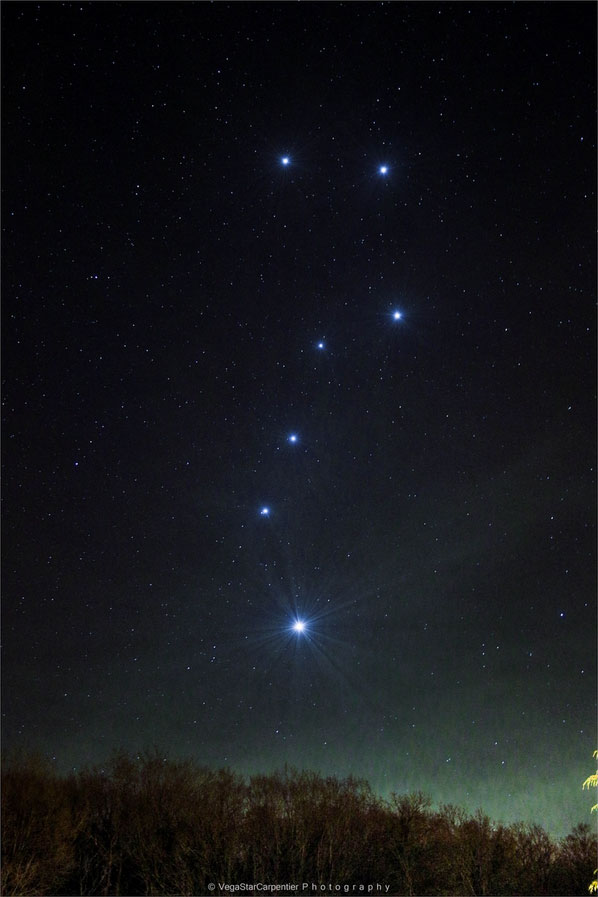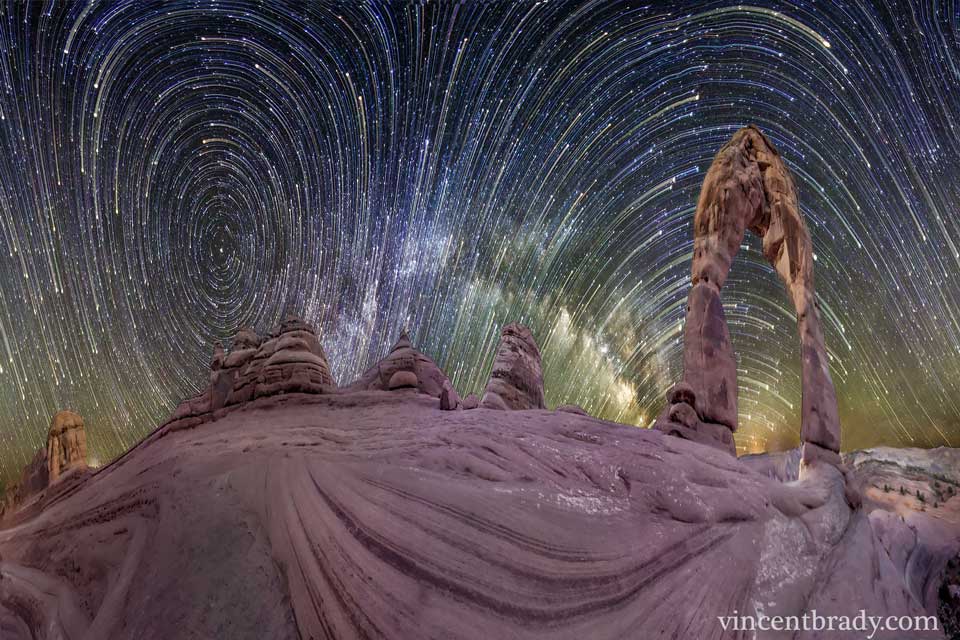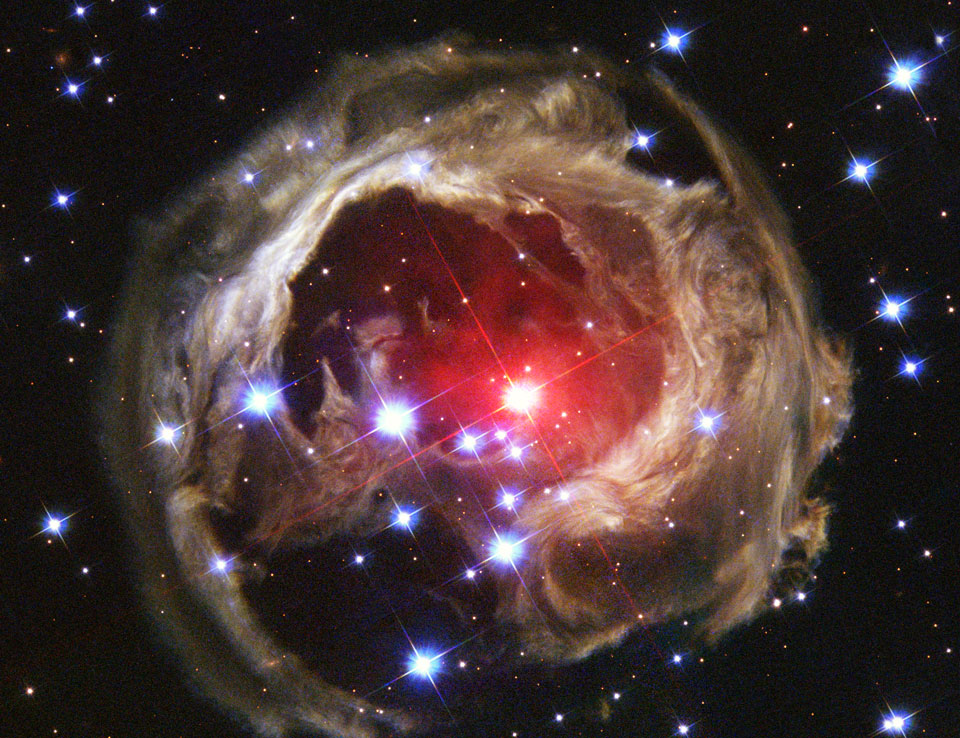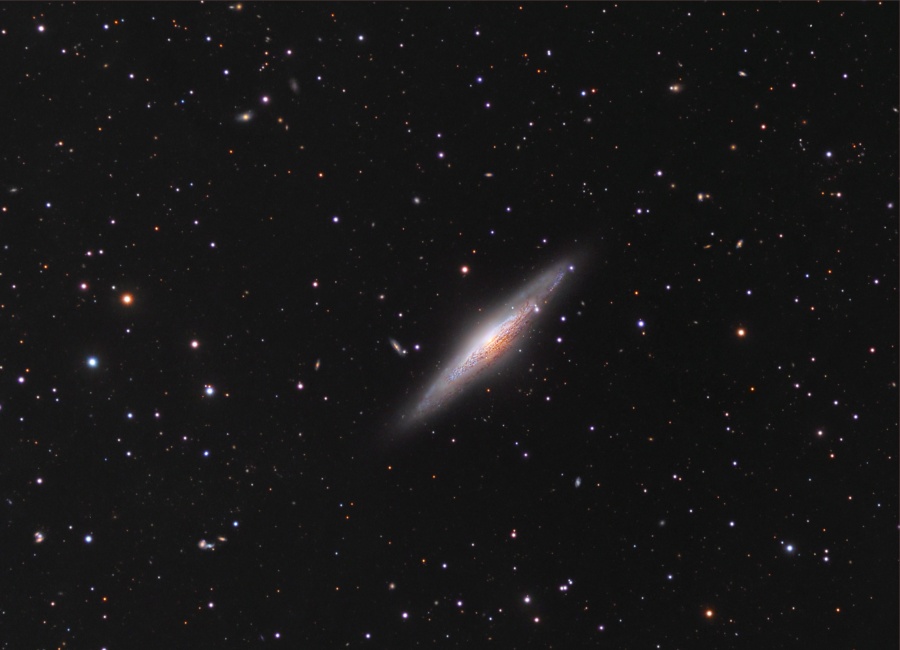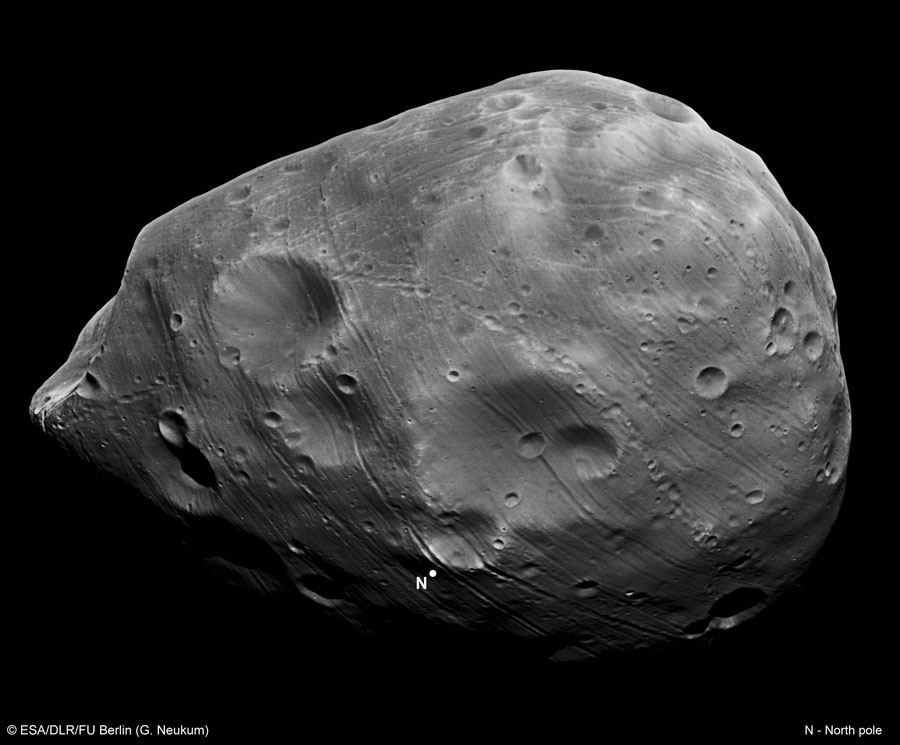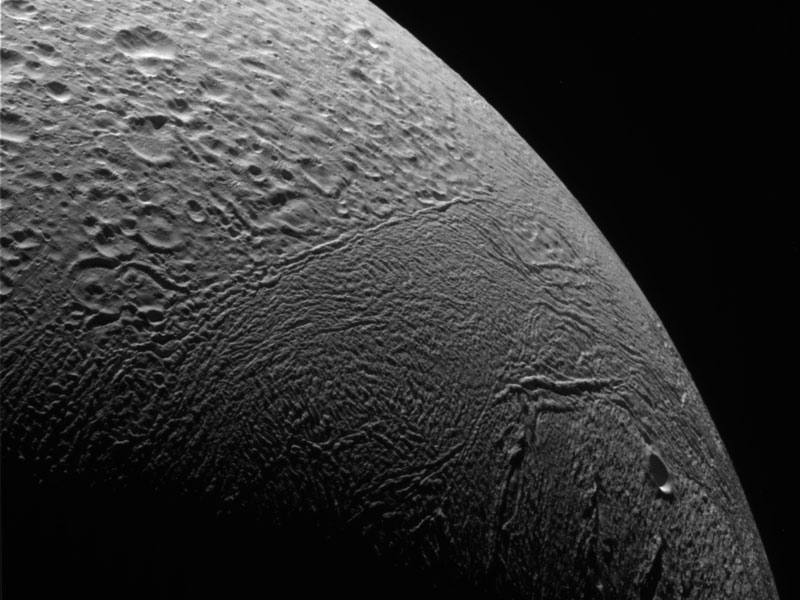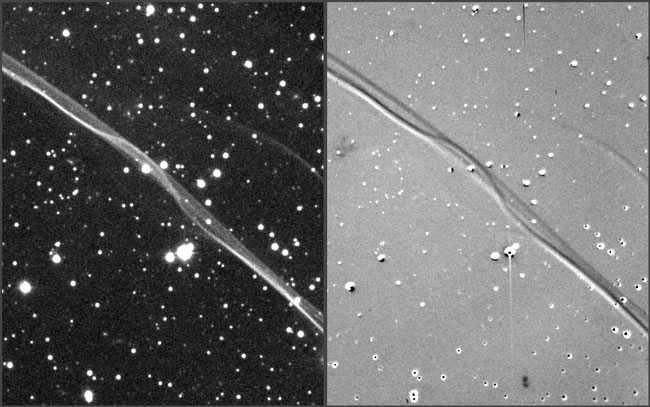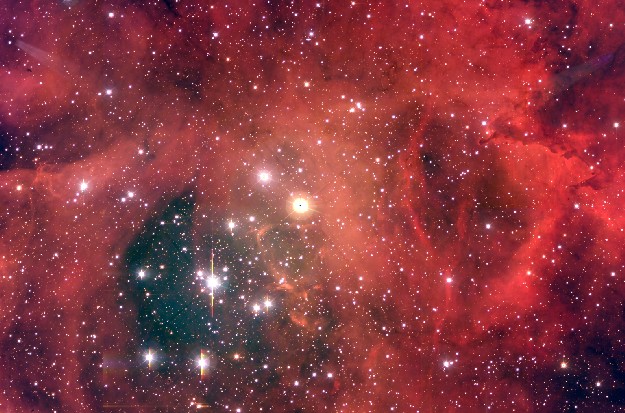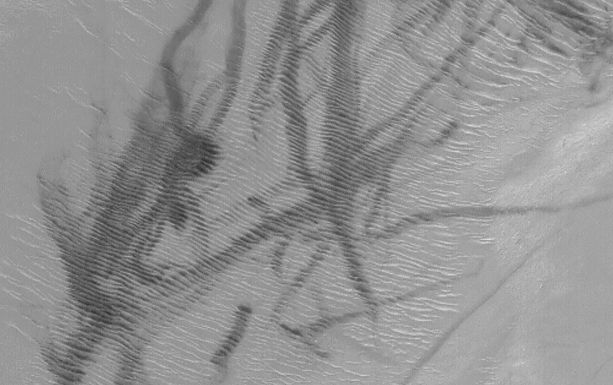| << Previous | Index | Next >> |
2015 Do you see it? This common question frequently precedes the rediscovery of one of the most commonly recognized configurations of stars on the northern sky: the Big Dipper. This grouping of stars is one of the few things that has likely been seen, and will be seen, by every human generation. In this featured image, however, the stars of the Big Dipper have been digitally enhanced -- they do not really appear this much brighter than nearby stars. The image was taken earlier this month from France. The Big Dipper is not by itself a constellation. Although part of the constellation of the Great Bear (Ursa Major), the Big Dipper is an asterism that has been known by different names to different societies. Five of the Big Dipper stars are actually near each other in space and were likely formed at nearly the same time. Relative stellar motions will cause the Big Dipper to slowly change its apparent configuration over the next 100,000 years.
2014 What's happened to the sky? A time warp, of sorts, and a digital space warp too. The time warp occurs because this image captured in a single frame a two and a half hour exposure of the night sky. As a result, prominent star trails are visible. The space warp occurs because the picture is actually a full 360 degree panorama, horizontally compressed to fit your browser. As the Earth rotated, stars appeared to circle both the North Celestial Pole, on the left, and the South Celestial Pole, just below the horizon on the right. The above panorama over Arches National Park in Utah, USA, was captured two weeks ago during early morning hours. While the eye-catching texture of ancient layered sandstone covers the image foreground, twenty-meter tall Delicate Arch is visible on the far right, and the distant arch of our Milky Way Galaxy is visible near the image center.
2013 What caused this outburst of V838 Mon? For reasons unknown, star V838 Mon's outer surface suddenly greatly expanded with the result that it became the brightest star in the entire Milky Way Galaxy in January 2002. Then, just as suddenly, it faded. A stellar flash like this had never been seen before -- supernovas and novas expel matter out into space. Although the V838 Mon flash appears to expel material into space, what is seen in the above image from the Hubble Space Telescope is actually an outwardly moving light echo of the bright flash. In a light echo, light from the flash is reflected by successively more distant rings in the complex array of ambient interstellar dust that already surrounded the star. V838 Mon lies about 20,000 light years away toward the constellation of the unicorn (Monoceros), while the light echo above spans about six light years in diameter.
2012 This elegant island universe is cataloged as NGC 2683. It lies a mere 16 million light-years distant toward the northern constellation Lynx. A spiral galaxy comparable to our own Milky Way, NGC 2683 is seen nearly edge-on in the cosmic vista. Blended light from a large population of old, yellowish stars forms the remarkably bright galactic core. Their starlight silhouettes the dust lanes along winding spiral arms, dotted with NGC 2683's young blue star clusters. The sharp image was recorded through the lens of a refracting telescope that shows brighter foreground Milky Way stars as colorful and round, lacking diffraction spikes characteristic of images from reflecting telescopes with internal supports. The many more distant galaxies scattered through the background appear as fuzzy, extended sources.
2011 Late last year, a new, remarkably bright storm erupted in Saturn's northern hemisphere. Nicknamed "the Serpent Storm", the northern hemisphere disturbance is still going strong and now circles far around the planet. Offering spectacular space-based views to the Saturn-orbiting Cassini spacecraft, the storm shows enough contrast with the banded cloud tops to be visible with even modest ground-based equipment, as seen in this sharp image from Buena Vista, Georgia, USA, planet Earth. Amateur astronomers first spotted the bright storm in early December 2010, with the ringed gas giant rising in predawn skies, and continue to monitor the storm's progress.
2010 Why is this small object orbiting Mars? The origin of Phobos, the larger of the two moons orbiting Mars, remains unknown. Phobos and Deimos appear very similar to C-type asteroids, yet gravitationally capturing such asteroids, circularizing their orbits, and dragging them into Mars' equatorial plane seems unlikely. Pictured above is Phobos as it appeared during last week's flyby of ESA's Mars Express, a robotic spacecraft that began orbiting Mars in 2003. Visible in great detail is Phobos' irregular shape, strangely dark terrain, numerous unusual grooves, and a spectacular chain of craters crossing the image center. Phobos spans only about 25 kilometers in length and does not have enough gravity to compress it into a ball. Phobos orbits so close to Mars that sometime in the next 20 million years, tidal deceleration will break up the rubble moon into a ring whose pieces will slowly spiral down and crash onto the red planet. The Russian mission Phobos-Grunt is scheduled to launch and land on Phobos next year.
2009
2008 What does the surface of Saturn's ice-spewing moon Enceladus look like? To help find out, the robotic Cassini spacecraft now orbiting Saturn was sent soaring past the cryovolcanic moon and even right through one of Enceladus' ice plumes. Cassini closed to about 52 kilometers during its closest encounter to date. The above unprocessed image was taken looking down from the north, from about 30,000 kilometers away. Visible are at least two types of terrain. The first type of terrain has more craters than occur near Enceladus' South Pole. The other type of terrain has few craters but many ridges and grooves that may have been created by surface-shifting tectonic activity. Exogeologists are currently poring over this and other Cassini images from last Wednesday's flyby to better understand the moon's patch-work surface, its unusual ice-geysers, and its potential to support life. Cassini is scheduled to fly by Enceladus at least nine more times, including an even closer pass of just 25 kilometers this coming October.
2007 Celestial and terrestrial lights are featured in this stunning image that includes the Moon in phases of the total lunar eclipse of March 3rd. In the foreground, the distinctively-shaped Eiffel Tower, over 300 meters tall, is a well-known tourist destination and one of the most visited buildings in the world. Of course the Moon is even more recognizable, but harder to visit. The last lunar tour was undertaken nearly 35 years ago, during the Apollo 17 mission.
2006 A well-known asterism in northern skies, The Big Dipper is easy to recognize even when viewed upside down. Part of the larger constellation of Ursa Major, the bright dipper stars above are named (left to right along the dipper) Dubhe, Merak, Phecda, Megrez, Alioth, Mizar/Alcor, and Alkaid. Of course, stars in any given constellation are unlikely to be physically related. But surprisingly, most of the big dipper stars do seem to be headed in the same direction as they plough through space, a property they share with other stars spread out over an even larger area across the sky. Their measured common motion suggests that they all belong to a loose, nearby star cluster, thought to be on average only about 75 light-years away and up to 30 light-years across. The cluster is more properly known as the Ursa Major Moving Group.
2005 The surface of Enceladus is as white as fresh snow. Still, an impressive variety of terrain is revealed in this contrast enhanced image. At a resolution of about 30 meters per pixel, the close-up view spans over 20 kilometers - recorded during the touring Cassini spacecraft's March flyby of the icy Saturnian moon. Enceladus is known to be the most reflective moon in the solar system, and the recent Cassini encounters have also detected the presence of an atmosphere, making Enceladus the second moon of Saturn with such a distinction. In fact, Enceladus' fresh looking surface and significant atmosphere both indicate that the tiny, 500 kilometer diameter moon is active. Researchers suspect that ice volcanos or geysers coat the surface with fresh material and replenish the moon's atmosphere, ultimately providing the icy particles that compose Saturn's tenuous E ring.
2004 What's the farthest galaxy known? The answer keeps changing as astronomers compete to find galaxies that top the list. The new claimed record holder is now the faint smudge indicated in the above images by an 8.2-meter Very Large Telescope (VLT) operating in Chile. Detected light left this galaxy 13.2 billion of years ago, well before the Earth formed, when the universe was younger than 3 percent of its present age. Astronomers have estimated a redshift of 10 for this galaxy, the first double-digit claim for any galaxy. Young galaxies are of much interest to astronomers because many unanswered questions exist on when and how galaxies formed in the early universe. The distant redshift, if confirmed, would also give valuable information about galaxy surroundings at the end of the universe's dark age. Although this galaxy's distance exceeds that of even the farthest known quasar, it is still in front of the pervasive glowing gas that is now seen as the cosmic microwave background radiation.
2003 Suddenly, in the year 1006 AD, a new star appeared in the sky. Over the course of just a few days, the rogue star became brighter than the planet Venus. The star, likely the talk of everyone who could see it, was recorded by people who lived in areas now known as China, Egypt, Iraq, Italy, Japan, and Switzerland. The celestial newcomer, now known to be a supernova, took months to fade. Modern observations have been used to measure the speed of the still-expanding shock wave, allowing a better estimate of its distance and hence a better estimate of the true brightness of the supernova. It turns out SN 1006 likely achieved an apparent visual magnitude of -7.5, making it the brightest supernova on record. The shock wave was imaged in 1998 from CTIO (left panel), and then subtracted from a similar image taken in 1986 (right panel), highlighting the relative expansion.
2002 In the heart of the Rosette Nebula lies a bright open cluster of stars that lights up the nebula. The stars of NGC 2244 formed from the surrounding gas only four million years ago and emit light and wind that define the nebula's appearance today. High energy light from the bright young stars of NGC 2244 ionizes the surrounding hydrogen gas clouds to create the red emission nebula appearance. The hot wind of particles that streams away from the cluster stars contributes to an already complex menagerie of gas and dust filaments while slowly evacuating the cluster center. NGC 2244 measures about 50 light-years across, lies about 4500 light-years away, and is visible with binoculars towards the constellation of Monoceros.
2001 Six years ago, a cluster of three ultraviolet telescopes flew into orbit on the Astro-2 mission aboard the space shuttle Endeavour. Seen here perched in Endeavour's payload bay about 350 kilometers above the Australian desert are the Hopkins Ultraviolet Telescope (HUT), the Ultraviolet Imaging Telescope (UIT), and the Wisconsin Ultraviolet Photo-Polarimeter Experiment (WUPPE). HUT is in front of the other instruments with a silver, conical-shaped star tracker at the left of the telescope cluster. The ultraviolet region of the electromagnetic spectrum lies at wavelengths shorter than blue light and can not be seen by human eyes. Almost all ultraviolet light from the cosmos is impossible to detect at the Earth's surface because it is absorbed by atmospheric ozone. But cruising high above the clouds and protective atmosphere, these instruments could explore the universe at wavelengths beyond the blue.
2000 Who's been marking up Mars? This portion of a recent high-resolution picture from the orbiting Mars Global Surveyor spacecraft shows twisting dark trails criss-crossing a relatively flat rippled region about 3 kilometers wide on the martian surface. Newly formed trails like these presented researchers with a tantalizing martian mystery but have now been identified as likely the work of miniature wind vortices known to occur on the red planet - martian dust devils. Another example of wind processes on an active Mars, dust devils had been detected passing near the Viking and Mars Pathfinder landers. Such spinning columns of rising air heated by the warm surface are common in dry and desert areas on planet Earth. Typically lasting only a few minutes, they becoming visible as they pick up loose dust. On Mars, dust devils can be up to 8 kilometers high and leave dark trails as they disturb the bright, reflective surface dust.
1999 In 1996, scientists melted a hole in the bottom of the world. In fact, several holes have been melted near the South Pole, and they are now being used as astronomical observatories. Astronomers with the Antarctic Muon and Neutrino Detector Array (AMANDA) lower into each vertical lake a string knotted with basketball-sized light detectors. The water in each hole soon refroze. The detectors are sensitive to blue light emitted in the surrounding clear ice. Such light is expected from ice collisions with high-energy neutrinos emitted by objects or explosions out in the universe. The above picture was taken 750 meters below the surface looking down into the abyss. Instruments were lowered down past 2000 meters. Data from AMANDA is already being collected and analyzed.
1998 When and where do clouds form on Mars? The Mars Global Surveyor spacecraft currently orbiting Mars is finding out. Photographs released last week showed clouds forming above Tharsis, a huge bulge on Mars about 4000 kilometers across and 7 kilometers high containing several large volcanoes. These clouds temporarily disappeared as a large dust storm emerged from the South, the first developing dust storm to be tracked by an orbiting spacecraft. Mars Global Surveyor continues to aerobrake during on its ongoing mission to survey the planet Mars.
1997 Comet Hale-Bopp is now much brighter than any surrounding stars. It can be seen even over bright city lights. Out away from city lights, however, it is putting on quite a spectacular show. Here Comet Hale-Bopp was photographed last week above Val Parola Pass in the Dolomite mountains surrounding Cortina d'Ampezzo, Italy. Comet Hale-Bopp's blue ion tale is created when fast moving particles from the solar wind strike recently expelled ions from the comet's nucleus. The white dust tail is composed of larger particles of dust and ice expelled by the nucleus that orbit behind the comet. Recent observations show that Comet Hale-Bopp's nucleus spins about once every 12 hours. Comet Hale-Bopp is now visible in both the early morning and early evening sky, and will continue to brighten this week.
1996 This close-up of the tops of Saturn's clouds was taken by the Voyager 1 robot spacecraft as it passed the giant planet in November 1980. Saturn's clouds are mostly composed of hydrogen and helium gas, but the small addition of other elements gives the clouds their colors. These colors have been computer enhanced in the above photograph. Usually the clouds are divided into just bands and belt, but the center of this photograph shows the addition of a red oval cloud. The oval's origin remains a mystery, although its color indicates that its composition is slightly different than surrounding clouds. A new spacecraft - Cassini - will visit Saturn and is currently scheduled for launch in 1997.
| << Previous | Index | Next >> |
